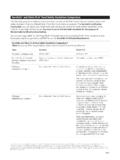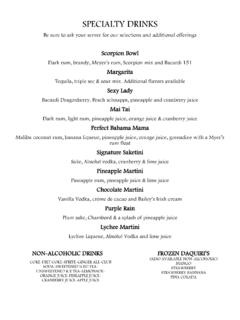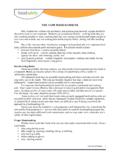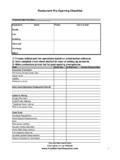Transcription of ServSafe 6th Edition
1 Reproducible for instructional use only. NOT for placement on Web sites. 2012 National restaurant Association Educational Foundation. All rights reserved. ServSafe , and the ServSafe logo are registered trademarks of the National restaurant Association Educational Foundation, and used under license by National restaurant Association Solutions, LLC, a wholly owned subsidiary of the National restaurant 1 of 2 ServSafe 6th EditionNew Content from the FDA Food Code Update Student VersionThe ServSafe 6th Edition has been updated to reflect the latest food safety science based on the 2011 Supplement to the 2009 FDA Food Code, job task analysis and industry best practices. This is NEW content and is not included in ServSafe textbooks prior to the 6th Edition nor is it currently covered in the ServSafe Manager Online Course.
2 It is strongly encouraged that you read this document and become familiar with each new topic as it is an important food safety practice. These updates may also be included on the ServSafe Food Protection Manager Certification CONTENT1. REPORTING HEALTH ISSUES (The Safe Food Handler)If a food handler has a sore throat with a fever, he or she must be restricted from working with or around food. The food handler can work with or around food when he or she has a written release from a medical practitioner. Food handlers who have had jaundice for less than seven days must be excluded from the operation. They must have a written release from a medical practitioner and approval from the regulatory authority before returning to RECALLS (Receiving)Food is sometimes recalled from the manufacturer.
3 This may happen when contamination is confirmed or suspected. It can also occur when items have been mislabeled or misbranded. Often food is recalled when food allergens have not been identified on the label. Most vendors will notify you of the recall. However, you should also monitor recall notifications made by the FDA and the USDA. Follow these guidelines when notified of a recall:q Identify the recalled food items by matching information from the recall notice to the Remove the item from inventory, and place it in a secure and appropriate Label the item in a way that will prevent it from being placed back in Refer to the vendor s notification or recall notice for what to do with the KEY DROP DELIVERIES (Receiving)Some foodservice operations receive food after-hours when they are closed for business.
4 This is often referred to as a key drop delivery. The delivery must be inspected once you arrive at the operation and must meet the following conditions:q It is from an approved It was placed in the correct storage location to maintain the required It was protected from contamination in It has not been It is honestly LABELING (Storage)Labeling Food For Use On-SiteAll items that are not in their original containers must be labeled. Food labels should include the common name of the food or a statement that clearly and accurately identifies Food That Is Packaged On-Site for Retail SaleFood packaged in the operation that is being sold to customers for use at home must be labeled with the following:q Common name of the food or a statement that clearly identifies Quantity of the List of ingredients in descending order by weight.
5 Q List of artificial colors, flavors, and chemical preservatives in the Name and place of business of the manufacturer, packer, or Source of each major food allergen contained in the food. Bulk Food in Self-Service AreasBulk food in self-service areas must be labeled. The label must be in plain view of the customer. When labeling food, you can include the manufacturer or processor label provided with the food. As an alternative, this information can be provided using a card, sign, or other labeling for instructional use only. NOT for placement on Web sites. 2012 National restaurant Association Educational Foundation. All rights reserved. ServSafe , and the ServSafe logo are registered trademarks of the National restaurant Association Educational Foundation, and used under license by National restaurant Association Solutions, LLC, a wholly owned subsidiary of the National restaurant 2 of 24.
6 DATE MARKING (Storage)Ready-to-eat TCS food can be stored for only seven days if it is held at 41 F (5 C) or lower. The count begins on the day that the food was prepared or a commercial container was opened. For example, a food handler that prepared and stored potato salad on October 1 would write a discard date of October 7 on the BARE-HAND CONTACT WITH READY-TO-EAT FOOD (Service)Do not handle ready-to-eat food with bare hands. Food handlers must wear single-use gloves or handle this food with spatulas, tongs, deli sheets, or other EMERGENCIES AFFECTING THE FACILITIES (Facilities)Certain crises can affect the safety of the food you serve. Some of the most common include electrical power outages, fire, flooding, and sewage backups.
7 These are considered by the local regulatory authority to be imminent health hazards. An imminent health hazard is a significant threat or danger to health that requires immediate correction or closure to prevent injury. When faced with any of these crises, you must first determine if there is a significant risk to the safety or security of your food. If the risk is significant, service must be stopped. Then the local regulatory authority must be CLEANING UP AFTER PEOPLE WHO GET SICK (Cleaning and Sanitizing)If a person has diarrhea or vomits in the operation, these spills must be cleaned up the correct way. Vomit and diarrhea can carry Norovirus, which is highly contagious. Correct cleanup can prevent food from becoming contaminated.
8 It will also keep others from getting sick. The way you clean up these substances is different from the way you clean other items in the operation. Your operation needs to consider items such as the following:q How you will contain substances and remove How you will clean, sanitize, and disinfect When to throw away food that may have been Equipment needed to clean up these When a food handler must wear personal protective How sick customers will be quickly removed from the CLEANING STATIONARY EQUIPMENT (Cleaning and Sanitizing)Equipment manufacturers will usually provide instructions for cleaning and sanitizing stationary equipment, such as a slicer. In general, follow these steps:q Unplug the Take the removable parts off the equipment.
9 Wash, rinse, and sanitize them by Scrape or remove food from the equipment Wash the equipment Rinse the equipment surfaces with clean Sanitize the equipment Allow all surfaces to air-dry. Put the unit back pieces of equipment, such as soft-serve yogurt machines, are designed to have cleaning and sanitizing solutions pumped through them. Because many of them hold and dispense TCS food, they must be cleaned and sanitized every day unless otherwise indicated by the manufacturer.













